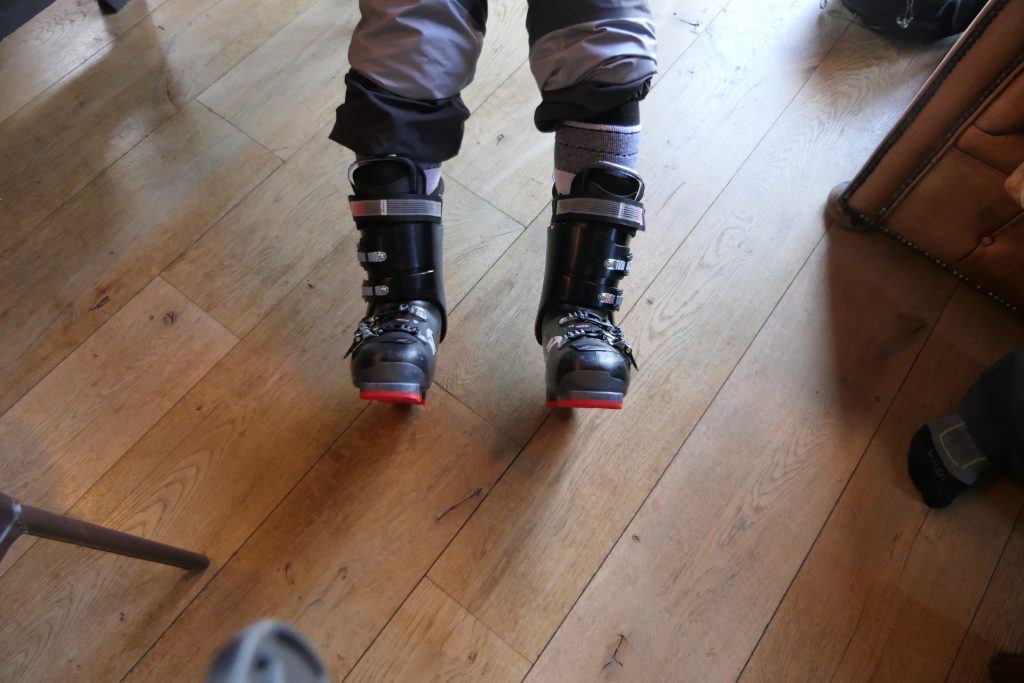Steve
- Pivoting
- Combining Dynamics with Pivoting
- Eco Mode
- Body Management/ Hip Angulation
Michael, Lisa, Naomi
- Skating
- Ski Boot Alignment
- Snowplough
- Dynamics
- Combining Dynamics with Snowplough
- Skating Step Turns
- Parallel Turns
- Pivoting
- Combining Dynamics with Pivoting
Una , Amber
- Dynamics
- Body Management/Hip Angulation
- Forward Pressure/Stopping Hip Rotation
- Pivoting
Skating – Adductors
Skiing is just disguised skating. The main difference is the skis are wide and have two edges. When diverging the skis outwards at the tips into a skating stance the skis want to flatten on the snow and the stiff shaft of the ski boots will pull the knees outward. The adductor muscles need to be engaged to hold the skis on their inside edges. This is a pattern of muscle use – the adductors of both legs contracting – that should be maintained when skiing parallel.
Skis diverging yet holding the adductor muscles active on both legs.
To skate more efficiently – fall forward and let gravity generate the forward propulsion.
The key to skiing is being aware of the motion of the centre of mass due to skating and gravity.
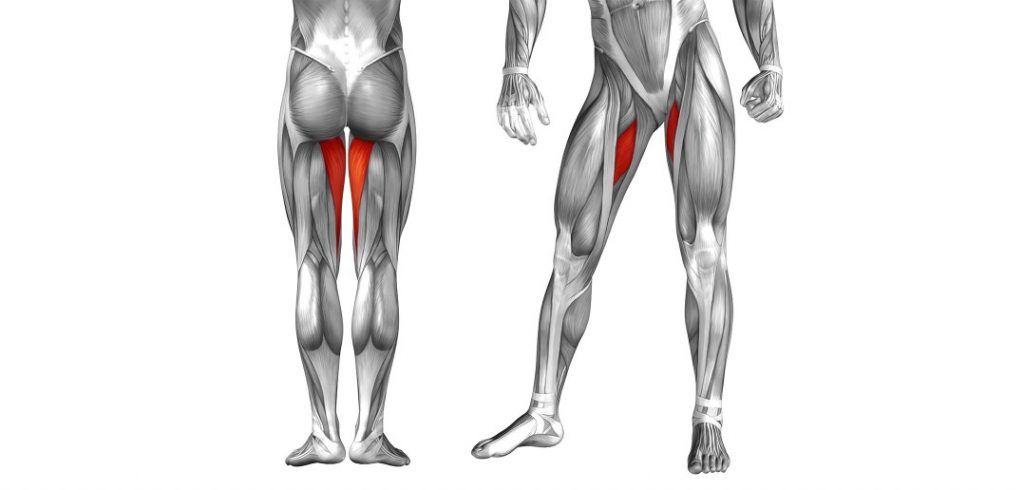
Difference between Skating and Snowplough Braking
One difference between snowplough (converging skis) and skating (diverging skis) is that while skating requires the adductor muscles to be active while a braking (stopping) snowplough requires them to be relaxed – so that a wide plough can be made from the hip joints.
Using Skating Muscle to Turn in a Plough
Integrating the skating muscle (adductor) with the plough begins with a simple act of activating the muscle on one leg only – the one you want to push (deflect) you around (left leg turns you to the right). You simply get more strongly deflected due to placing one ski slightly more on edge. There is no “transfer of weight” etc. and you are not trying to apply “pressure” to a ski.
Skating Step turns
Now proper skating step turns! Incrementally moving the centre of mass inwards.
The skating step turns lead direct to parallel turns when the inside ski is simply not lifted off the snow.
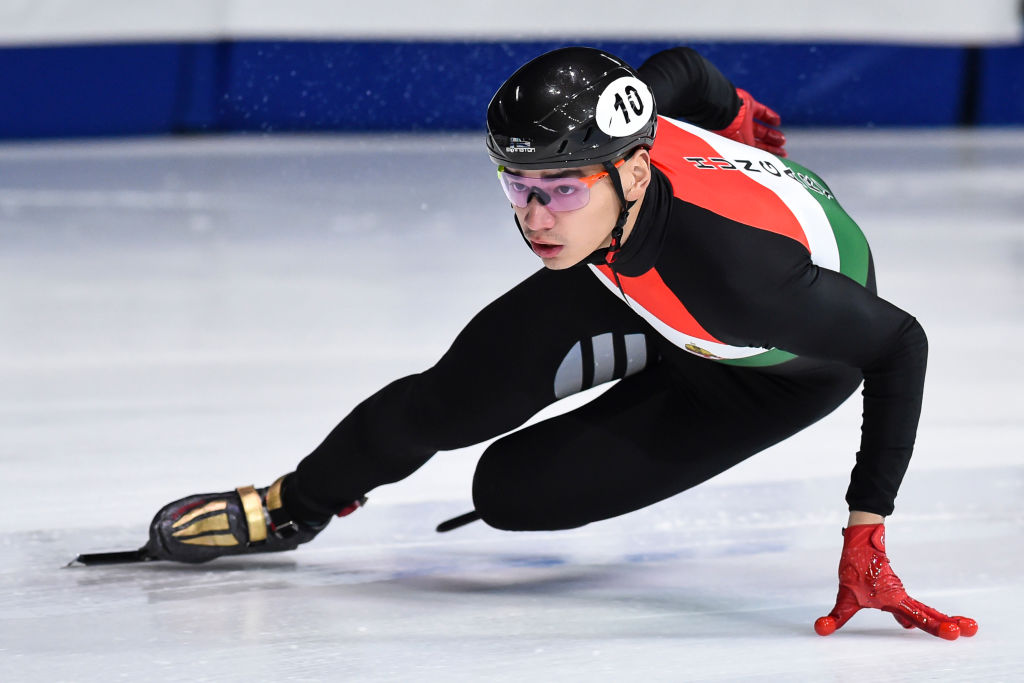
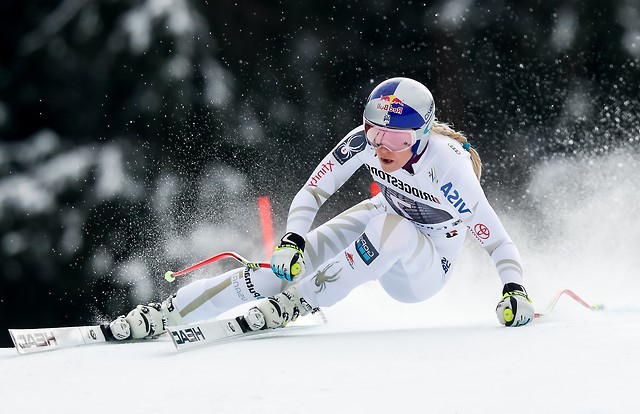
Basic Dynamics
- Skis must be travelling forward – like a bicycle
- This is mainly about using the outside leg (start of new turn) to push the centre of mass into the centre of the new turn – for the whole duration of the turn
- There is no “balance” when skiing – dynamics is the physics of disequilibrium
- You are looking for stability from organised accelerations (ski technology!)
- Notice in the photos below the outside leg is essentially straight in a skating action (flexion for absorption and other purposes is primarily at the hip joint)
- The centre of mass goes down toward the snow – and to complete the turn it comes back up – like a motorbike in a turn
- There is no “Centrifugal Force” acting on the skier – only a deflection inward away from a straight line. This deflection is used to lift the skier up at the end of the turn – which involves “finishing” the turn – I.E. turning almost back up the hill.
- Remain square to the skis (follow the skis around the turn with your body) until you are really comfortable with movement of the centre of mass and clearly aware of moving it.
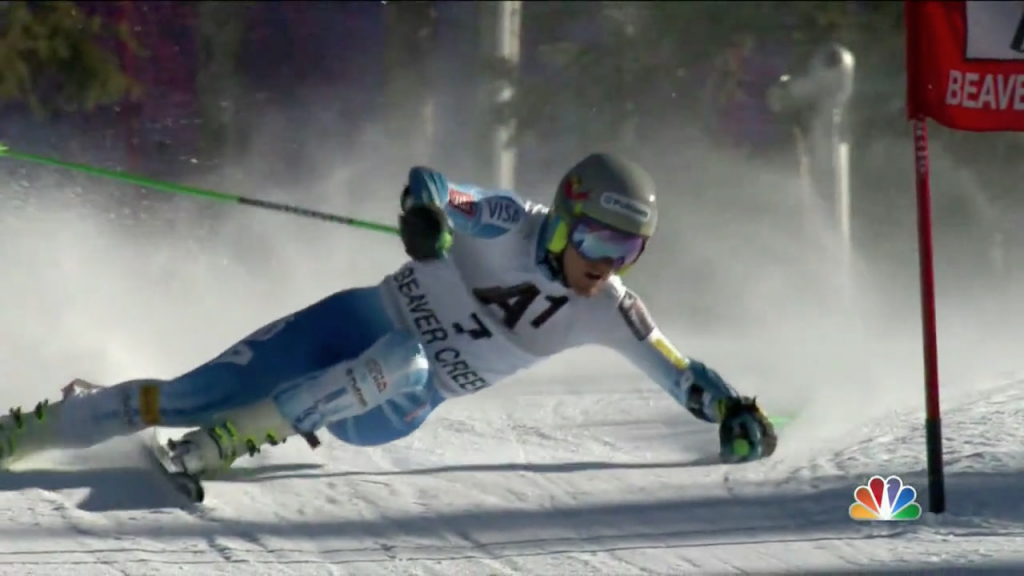
Combining Dynamics with Snowplough
Dynamics is explained in terms of the mechanics of accelerations. (F=mA Newton’s 2nd Law). In skiing this means you move your centre of mass (either falling or with a push) in the direction you want to turn. You do not transfer your weight to the outside ski as is incorrectly taught in ski schools.
In the Snowplough using dynamics requires the adductors of both legs to be engaged and now the “deflection” is carried out by moving the Centre of Mass (CoM) across the skis in the direction of turning. The displacement of the CoM affects the geometry of both skis with respect to the slope (one goes flatter and the other more on edge) and that’s where the deflection comes from.
Pivot (Skis sliding Sideways)
Pivoting is derived from the skis sliding sideways and can be developed from side slipping (It’s a braking form of turning). With a “pure pivot” as an exercise there is no forward travelling of the ski across the hill. Support for the centre of mass is now provided by support from a downhill pole plant. This is the real reason why we have ski poles! There is a full dedicated explanation of pivoting at the following link: “PIVOT“
Combining Dynamics and Pivot
- Dynamics depends on forward motion of the skis and lateral falling/pushing of the centre of mass
- Pivot depends on lateral motion of the skis – but always with the centre of mass being driven inward (toward the turn centre)
- The two can be combined – when there is both forward and lateral motion – making overall control of trajectory and speed totally under control of the skier
- In all cases there must be active adductor muscle use – and the feet must be “everted” i.e. turned outward inside the ski boots – diverging sightly (skating stance)
- The essential element to take from combining pivot and dynamics is to execute the turn transition from the uphill edge of the uphill ski – noting that the ski enters the new turn more easily than when on its inside edge and this also prevents stemming (and body rotation)
Eco Mode
Completing the turns using the outside/downhill ski to lift the body up and out of the end of the turns. This is effective in using the energy built up during the turn and so is less tiring than using leg retraction followed by a push from the uphill leg.
It’s necessary to be able to complete turns with different movements patterns – the full range goes from leg retraction, just letting the ski lift the body up and out of the turn on the straight outside leg to literally jumping up.
Economy Mode is using the ski to lift you out of each turn – but it makes getting from edge to edge (turn transition) slower.
Body Management (Hip Angulation)
Take a look at the two Olympic champion skiers in the photograph below.
Killy’s image from the 1960s has his chest facing downhill whereas Noel’s image from 2022 has his chest facing forward. What Killy is doing destroys your lower back and is probably why he never went on skis again after he stopped racing.

Protecting the Spine
- Hold the front of the pelvis up – aiming for “neutral pelvis”
- During the turn pull the outer hip backwards so that the ski doesn’t pull it in front of your ribs
- Look for a stretch between the ribs and hip joint
- Look for a reflex contraction of the lower abdominals – the postural reflex
- Keep the shoulders/chest following the skis (to some degree)
- Always “counter turn” the pelvis more than the chest/shoulders (It’s only the pelvis that should “face downhill”)
- Pulling the hip backwards also prevents both hip rotation and full upper body rotation
Source of Hip Angulation
The upper body needs to tilt forward over one hip joint – then rotate around it. This is in addition to pulling back the outside hip etc.
The body shape produced alters the location of the centre of mass enabling pressure on the ski fronts and also greater agility both into and out of turns – and pole planting if the skis are swinging laterally.
The hip angulation also provides flexion of the hip joint that gives absorption of shocks. Increased angulation also increases the edge angle of the skis to the snow and may alter the turn radius and grip.
Angulation when upright and pivoting has another function – when ANTICIPATING the next turn it is used to get the Centre of Mass out of the existing turn (by tilting the torso forward at the hip ) and letting the Centre of Mass move over the skis to plant the ski pole downhill for a strong, clear and definite support.
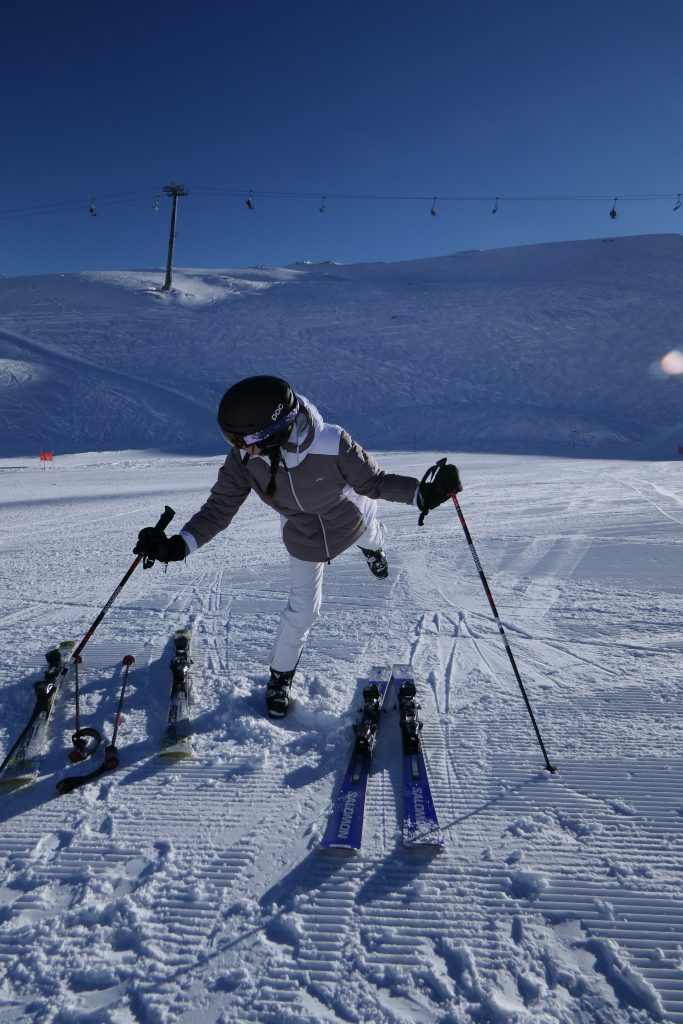
When the entire body inclines into the turn with hip angulation present this below is what it looks like.

Ski Boot Alignment
Before and after…
Shops align boots with the client standing, bending their knees and loading up the feet.
You just need to sit on a bench and straighten out your legs completely – feet hip with apart (flex only at the hips) – then you see the real morphology of the leg bones

